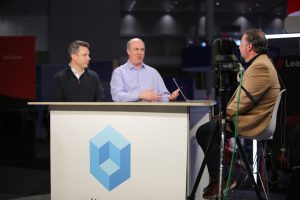From powering predictive models to streamlining operations, artificial intelligence is transforming enterprise AI into a story of integration, not disruption.
Red Hat Inc. is doubling down on the belief that AI should enhance existing enterprise systems rather than replace them. At the heart of this approach is infrastructure: stable, open and built to scale, according to Stu Miniman (pictured, right), senior director of market insights at Red Hat.

Red Hat’s Brian Gracely and Stu Miniman talk with theCUBE about the company’s momentum across its hybrid cloud ecosystem.
“Open source unlocks the world’s potential,” Miniman said “We’re not building all the applications. We’re giving you the tools and the capabilities and freeing up your people to be able to take advantage of that more than anything else.”
Miniman and Brian Gracely (left), senior director of portfolio strategy at Red Hat, spoke with theCUBE Research’s Rob Strechay at Red Hat Summit, during an exclusive broadcast on theCUBE, SiliconANGLE Media’s livestreaming studio. Their discussion focused on OpenShift’s growing role in enterprise AI and virtualization, the value of stable platforms and the company’s momentum across its hybrid cloud ecosystem. (* Disclosure below.)
OpenShift lays the foundation for enterprise AI
The recent general availability of Red Hat Enterprise Linux AI and OpenShift Lightspeed represents more than a product launch; it marks a key moment in Red Hat’s push to operationalize AI on trusted infrastructure. OpenShift users can extend their environments to support AI workloads without major rewrites or replatforming, according to Miniman.
“Last year, we had an AI vision,” he said. “Now it was like … Ansible Lightspeed was out there, but now RHEL AI, RHEL Lightspeed and OpenShift Lightspeed are both generally available, and they actually look similar even though they’re developed very different for very different use cases.”
This continuity especially appeals to enterprise teams deploying AI. Red Hat’s platform model lets customers build enterprise AI capabilities atop systems they already know, saving time, reducing risk and accelerating skill development, Gracely explained.
“They’re going, ‘Oh wait, all this stuff I can just layer on top of OpenShift. I’ve been working with that for a bunch of years. I’ve got expertise in that. My application team already use it,’” he said. “They’re really excited that it’s not a completely new thing … it’s just going to drop in and play with what they want to deal with.”
Here’s the complete video interview, part of SiliconANGLE’s and theCUBE’s coverage of Red Hat Summit:
(* Disclosure: TheCUBE is a paid media partner for Red Hat Summit. Neither Red Hat Inc., the primary sponsor of theCUBE’s event coverage, nor other sponsors have editorial control over content on theCUBE or SiliconANGLE.)
Photo: SiliconANGLE
Your vote of support is important to us and it helps us keep the content FREE.
One click below supports our mission to provide free, deep, and relevant content.
Join our community on YouTube
Join the community that includes more than 15,000 #CubeAlumni experts, including Amazon.com CEO Andy Jassy, Dell Technologies founder and CEO Michael Dell, Intel CEO Pat Gelsinger, and many more luminaries and experts.
THANK YOU



